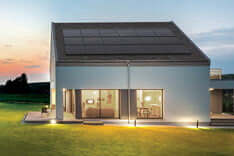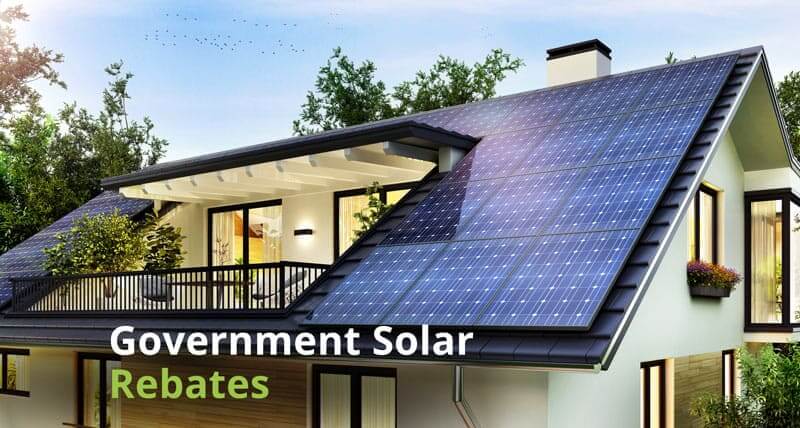It’s essential to highlight that there’s a significant difference between a solar collector and a solar panel.
A solar collector is a device that collects solar radiation from the sun. That energy can be used to heat fluids and air, as an alternative for traditional domestic water heating. On the other hand, solar panels produce electricity.
In this article, we’ll provide you with information on the different types of solar collectors, their features, and their uses.

Table of Contents
ToggleWhat is solar collector?
Solar collectors are devices that collect the sun’s radiation to generate heat for heating water, cooking food, or generating electricity. Solar collectors are generally mounted on the roof.
They can be concentrating and non-concentrating depending on their design. They usually include a heat carrier such as thermal oil or water.
What is a solar collector used for?
Solar collectors can be used both for residential and industrial purposes.
For residential purposes, they can be used for hot water and district heating and cooling. While for industrial purposes they can meet the demand for hot water, steam, or hot air in the manufacturing process. Also, in some instances, cooling applications can be configured.
How does a solar collector work?
First, the solar radiation is transmitted into the transparent cover of the solar collector. The solar energy absorbed by the transparent surface is confined within the inside of the solar collector.
To convert the radiation from the sun to heat, the solar collector uses coolant. With the energy trapped inside, the coolant or the heat transfer liquid within the tubes will be heated. The heated liquid will transfer its heat to thermal systems or anything that utilizes heat, whilst being circulated.
Solar collector parts
A solar collector is composed of three main parts:
- A transparent cover,
- Tubes with a coolant or heat transfer liquid, and
- An insulated back plate.
The tubes are usually made from copper and the back plate is painted black for maximum solar energy absorption. Solar collectors are insulated as well to avoid heat losses.
Classification of solar collectors
Solar collectors are either non-concentrating collectors or concentrating collectors.

1. Non-concentrating solar collectors
Most of the time, solar thermal energy systems for heating water or air have non-concentrating collectors. The transparent surface or the collector area where the solar radiation is transmitted is also where the absorption of the solar energy or radiation occurs.
Flat-plate collectors, which are a type of solar collector, are very common non-concentrating collectors for buildings that have hot water storage and space heating. Solar water heaters, whether for showering or for heating swimming pools, are non-concentrating collectors that use a heat-transfer fluid to generate heat.
2. Concentrating solar collectors
Concentrating solar collectors have a bigger transparent cover than absorber areas. This kind of collector concentrates the solar energy onto the absorber.
Usually used in solar thermal power plants, these collectors can tilt throughout the day to follow the sun and receive the highest degree of concentration possible. With concentrating solar collector systems, power plants can generate electricity efficiently because of the high temperature they can produce.
Types of solar collectors
All solar collectors are designed for the same purposes, collecting and focusing the energy from the sun. However, there are various types of solar collectors with diverse purposes and scales of application.
These are the most common types of solar thermal collectors:
- Flate plate solar collectors,
- Evacuated tube solar collectors,
- Line-focus solar collectors,
- Point focus solar collectors, and
- Fresnel collector.
1. Flat plate solar collectors
Flat plate solar collectors are made out of metal, usually copper or aluminium, as they are good conductors of heat. They also have some sort of transparent glazing on top that serves as a cover for the dark-coloured absorber plate. To minimize heat losses, the sides and the bottom of this type of collector are covered with insulation.
The solar energy/radiation is transmitted through the transparent glazing cover and is received by the absorber plate. As the plate heats up, the heat will be transferred to the coolant (water or air) held between the glazing and the plate.

2. Evacuated tube solar collectors
An evacuated tube solar collector utilizes evacuated tubes to produce heat for water usage. These tubes use a vacuum or evacuated space to collect solar energy/radiation efficiently and their thermal or heat losses to the environment are extremely low.
This solar collector’s absorber plate is a metal tube placed on the inner part of the device. The inner metal tube is connected to a heat pipe which carries the energy collected from the sun to the water. Once the solar energy moves from the hot end of the pipe to the cold end, the thermal energy is transported into the water that is heated and ready for use.
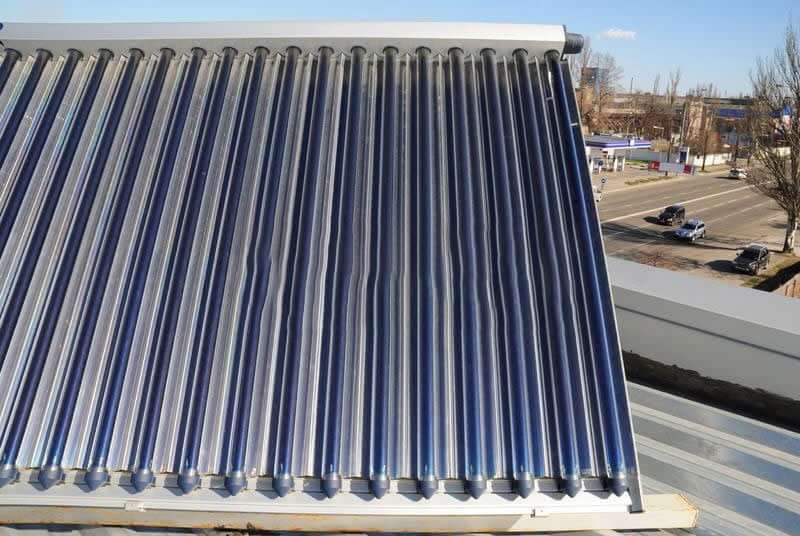
3. Line focus solar collectors
This type of solar collector utilizes long parabolic-shaped reflectors to collect the sun’s radiation and concentrate the sunlight on a receiver pipe that runs down into a long trough. Line-focus solar collectors are very high-powered and can focus the sun from 30 to 100 times its average intensity. This is why these solar collectors are used chiefly for solar thermal power plants and not in residential areas.
Some reflectors can pivot to ensure maximum sunlight collection as the sun moves from east to west throughout the day. This sun-tracking system ensures maximum solar energy will be focused on the receiver pipe.
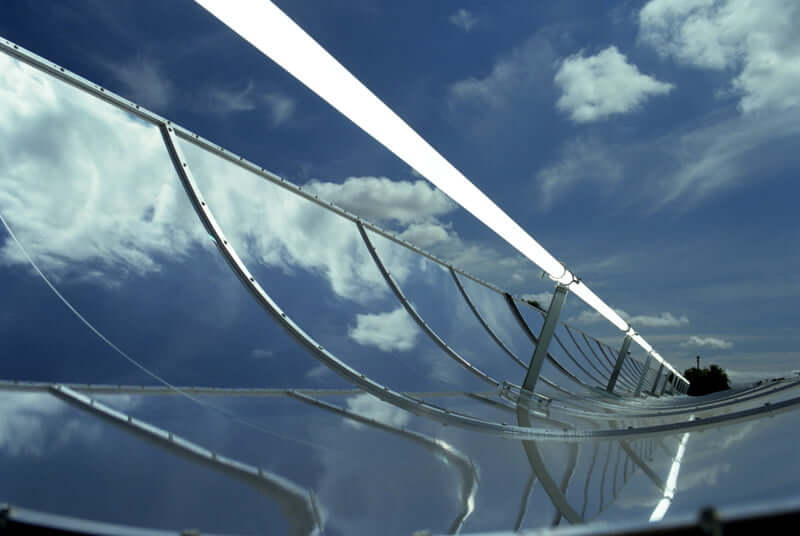
4. Point focus solar collectors
Point-focus solar collectors, also known as parabolic dish collectors, look very much like a giant TV satellite dish.
They gather sunlight by tracking the sun and concentrating solar energy at a focal point by reflecting it from their surface. They provide maximum in consistently sunny conditions and are mostly used in solar power plants and for research purposes.
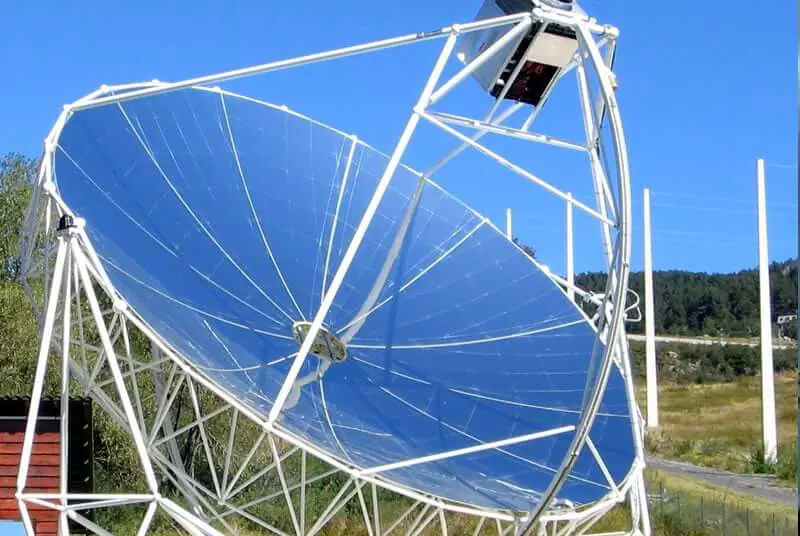
5. Fresnel collector
A Fresnel collector generates steam that is ready to use and can be optimized in terms of temperature and consistency for industrial application.
This is a linear concentrating solar collector composed of several rows of single-axis sun-tracking safety glass mirrors. It captures the sunlight and reflects it onto a stationary receiver above the collector. This receiver consists of a secondary reflector and a highly efficient vacuum absorber tube with selective coating. The Fresnel collector can provide heat up to 400°C and operate under up to 120 bars of pressure.
Solar collectors and their applications
These are the most common applications of the different types of solar collectors:
- Solar water heating,
- Space heating,
- Solar cooling, and
- Solar thermal power plants.
1. Solar water heating
Solar water heaters are using an array of solar collectors to collect energy from the Sun and convert it to heat. They are small black panels usually mounted on a roof.
Drinkable water can be heated in solar water heating systems either directly in the collector (direct systems) or indirectly by going through a heat exchange with a heat transfer fluid in the collector (indirect systems). Solar collectors used in SWH can also be a series of black collector tubes and not just panels. They generally have the same function as they are also made from heat-absorbing materials and they also conduct heat to a water supply.
2. Space heating
Solar space heating only works with an existing hydronic-based (hot water) heating system. A fluid, usually corn glycol, is circulated by the solar collectors through the solar array. The fluid will be heated and transferred back to the solar storage tank. While the heated fluid is circulating in the storage tank, the water in the tank will be heated, which could reach anywhere between 130 F and 175 F.
Through a heat exchanger, the hot water in the existing hydronic-based heating system is circulated in the storage tank. When the water goes through the heat exchanger, it will be heated and then returned to the heating system. This process efficiently shortens the amount of time it runs by keeping the heating system off after it provides warmth for the space that needs it.
Forced hot air (FHA) systems
Solar space heating can also be used with a Forced Hot Air system, which is a space heating system that heats the air with electric heaters, propane, or some other fuel, and not hot water.
FHA systems can be used with solar collectors by having a heat exchanger, specifically hot water coils or hydronic coils. The hydronic coils will allow the solar energy to circulate through the ductwork. With the circulation of the energy in the ductwork, the fan in the FHA system will start to run, and the home will be regularly kept warm while also reducing energy costs and preventing the burning of propane and other fuels at the same time.
3. Solar cooling
Solar cooling is a system that converts the Sun’s energy into cooling. It uses a thermally-driven cooling process which is then used to lower or control temperatures. There are two main purposes for solar cooling systems: refrigerating food and medicine storage and air conditioning (space cooling). They usually have three main components: a solar collector, a refrigeration or air conditioning plant, and a heat sink.
The refrigerant is an important part of providing cooling. It is a compound that absorbs heat from the environment and is able to create cooling when combined with components like compressors and evaporators. It is what creates pressure within a closed loop when receiving the heat from the solar collector.
Solar cooling systems are mostly used for refrigeration in RVs and vans for campers. They are also applied in vapour absorption refrigeration systems where extremely low temperatures and large thermal capabilities are required.
4. Solar thermal power plants
Solar thermal power plants generate electricity with the use of solar collectors, which utilize energy from the Sun. These systems have concentrating solar collectors to heat the heat transfer fluid to a very high temperature. The fluid transfers its heat to water to be able to produce steam, which is then converted into mechanical energy. The steam is what allows the turbines to work in the power plant.
The solar collectors in solar thermal power plants have two main components: reflectors (mirrors) and a receiver. The reflectors capture the Sun’s energy and focus it onto the receiver where the steam is produced.
Most of the time, these systems make use of solar collectors that have tracking systems to make sure that the Sun’s rays are focused at one point onto the receiver despite moving from east to west throughout the day. Solar thermal power plants also have thermal energy systems that allow solar collectors to still be able to store heat and produce energy even without the presence of the Sun during a cloudy day.
Who invented the solar collector?
The U.S. Department of Energy in their article The History of Solar points to two important dates in the evolution of solar collectors, 1767 and 1908.
- In 1767 Swiss scientist Horace de Saussure built the world’s first solar collector, an insulated box covered with three layers of glass to absorb heat energy, which was used in the 1830s by Sir John Herschel during his South Africa expedition for cooking.
- In 1908 William J. Bailley of the Carnegie Steel Company invented a solar collector with copper coils and an insulated box, incorporating copper insulation. This is still used in manufacturing today.
Advantages and disadvantages of solar collectors
There are many types of solar collectors and each has its own specific advantages and disadvantages compared to one another.
Advantages
- They are highly efficient.
- They are sustainable to extremely high temperatures (for concentrating solar collectors).
- They help reduce energy costs caused by heating or cooling appliances in the house.
- They can be used in many ways around houses or buildings.
- They only use a renewable source of energy which is the Sun.
- They can store heat for electricity generation overnight and during cloudy weather conditions.
- They are low-maintenance.
- They are convenient to use because they don’t require a lot of work for them to function while being mounted on the roof.
- They are environmentally friendly as they have no carbon emissions, unlike other heat sources.
Disadvantages
- They have an expensive initial cost for installation and maintenance.
- They are unable to produce electricity especially when the Sun has not been out for a couple of days.
- They require a sun tracking system to concentrate sunlight and achieve a high temperature.
- When used in solar thermal power plants, these solar collectors can disrupt wildlife due to the adverse effects of the reflectors or mirrors.
Table of Contents
Toggle
